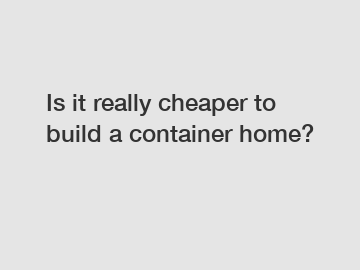Is it really cheaper to build a container home?
Is it really cheaper to build a container home?
Container homes have gained popularity in recent years due to their unique design, sustainability, and potential cost savings. But is it really cheaper to build a container home? Let's explore the advantages and considerations of constructing a container home and determine if it is a more affordable option compared to traditional homes.
Affordability: Myth or Reality?

When it comes to affordability, container homes often attract attention for their lower upfront costs. The containers themselves are readily available and can be purchased at relatively low prices, especially when compared to traditional building materials. This initial cost advantage can give the impression that building a container home is indeed cheaper.
However, it is important to consider other expenses that come with building a container home. Additional costs may include insulation, framing, plumbing, electrical work, and interior finishes. These expenses can quickly add up, and when combined with the cost of purchasing the containers, the overall price may not be significantly different from that of a conventional home.
Construction Challenges and Modification Costs.
One of the primary challenges of building a container home is modifying the containers to meet the requirements of a comfortable living space. Containers are designed for transportation and storage, not for human habitation. As a result, insulation, ventilation, and weatherproofing become necessary, which require additional materials and labor costs.
Furthermore, containers have a limited size and can be quite narrow, making it challenging to create spacious and functional living areas. Extensive modifications, such as combining multiple containers or adding extensions, can increase the complexity and cost of the construction process.
Regulations and Permits.
Before embarking on building a container home, it is essential to research the local regulations and obtain the necessary permits. Zoning and building codes may vary by location, and some areas may have restrictions on using containers as primary dwellings. Compliance with these regulations may require additional architectural and engineering services, adding to the overall cost of the project.
Long-Term Cost Savings.
While the initial construction costs of a container home may not always be significantly lower than traditional homes, long-term cost savings can still be achieved. Container homes are often lauded for their energy efficiency. With proper insulation and design choices, container homes can have excellent thermal performance, resulting in reduced heating and cooling costs over time.
Additionally, the durability of shipping containers can lead to lower maintenance expenses. Containers are designed to withstand harsh conditions during transportation, making them resistant to fire, pests, and extreme weather, which can translate into lower repair and replacement costs.
Closing Thoughts.
While container homes can offer unique design opportunities and potential cost savings in the long run, it is essential to carefully evaluate the associated expenses and challenges. By considering the costs of modifications, additional building materials, labor, and compliance with local regulations, you can make an informed decision about whether a container home is really cheaper for you.
If you are considering building a container home or have any further questions, feel free to contact us. Our team of experts is here to assist you in making the best decision for your housing needs.
[Contact us today to learn more and get started on your container home journey!].
Want more information on Luxury Expandable Container House, Expandable House Container, High quality 30ft Expandable Container Home? Feel free to contact us.
185
0
0


Comments
All Comments (0)